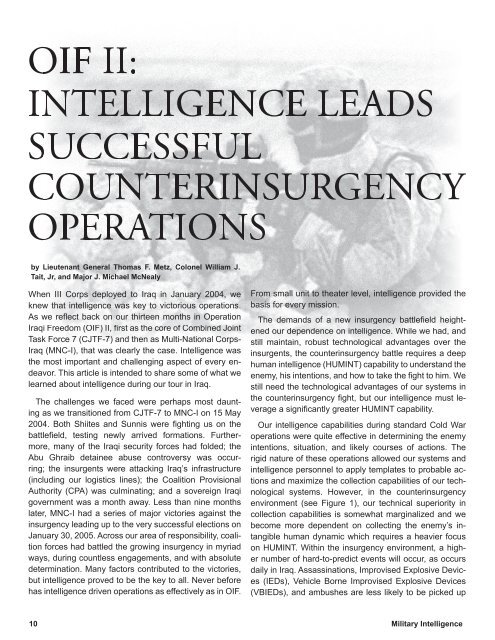Military Intelligence Professional Bulletin - Federation of American ...
Military Intelligence Professional Bulletin - Federation of American ...
Military Intelligence Professional Bulletin - Federation of American ...
Create successful ePaper yourself
Turn your PDF publications into a flip-book with our unique Google optimized e-Paper software.
OIF II:<br />
INTELLIGENCE LEADS<br />
SUCCESSFUL<br />
COUNTERINSURGENCY<br />
OPERATIONS<br />
by Lieutenant General Thomas F. Metz, Colonel William J.<br />
Tait, Jr, and Major J. Michael McNealy<br />
When III Corps deployed to Iraq in January 2004, we<br />
knew that intelligence was key to victorious operations.<br />
As we refl ect back on our thirteen months in Operation<br />
Iraqi Freedom (OIF) II, fi rst as the core <strong>of</strong> Combined Joint<br />
Task Force 7 (CJTF-7) and then as Multi-National Corps-<br />
Iraq (MNC-I), that was clearly the case. <strong>Intelligence</strong> was<br />
the most important and challenging aspect <strong>of</strong> every endeavor.<br />
This article is intended to share some <strong>of</strong> what we<br />
learned about intelligence during our tour in Iraq.<br />
The challenges we faced were perhaps most daunting<br />
as we transitioned from CJTF-7 to MNC-I on 15 May<br />
2004. Both Shiites and Sunnis were fi ghting us on the<br />
battlefi eld, testing newly arrived formations. Furthermore,<br />
many <strong>of</strong> the Iraqi security forces had folded; the<br />
Abu Ghraib detainee abuse controversy was occurring;<br />
the insurgents were attacking Iraq’s infrastructure<br />
(including our logistics lines); the Coalition Provisional<br />
Authority (CPA) was culminating; and a sovereign Iraqi<br />
government was a month away. Less than nine months<br />
later, MNC-I had a series <strong>of</strong> major victories against the<br />
insurgency leading up to the very successful elections on<br />
January 30, 2005. Across our area <strong>of</strong> responsibility, coalition<br />
forces had battled the growing insurgency in myriad<br />
ways, during countless engagements, and with absolute<br />
determination. Many factors contributed to the victories,<br />
but intelligence proved to be the key to all. Never before<br />
has intelligence driven operations as effectively as in OIF.<br />
10<br />
From small unit to theater level, intelligence provided the<br />
basis for every mission.<br />
The demands <strong>of</strong> a new insurgency battlefi eld heightened<br />
our dependence on intelligence. While we had, and<br />
still maintain, robust technological advantages over the<br />
insurgents, the counterinsurgency battle requires a deep<br />
human intelligence (HUMINT) capability to understand the<br />
enemy, his intentions, and how to take the fi ght to him. We<br />
still need the technological advantages <strong>of</strong> our systems in<br />
the counterinsurgency fi ght, but our intelligence must leverage<br />
a signifi cantly greater HUMINT capability.<br />
Our intelligence capabilities during standard Cold War<br />
operations were quite effective in determining the enemy<br />
intentions, situation, and likely courses <strong>of</strong> actions. The<br />
rigid nature <strong>of</strong> these operations allowed our systems and<br />
intelligence personnel to apply templates to probable actions<br />
and maximize the collection capabilities <strong>of</strong> our technological<br />
systems. However, in the counterinsurgency<br />
environment (see Figure 1), our technical superiority in<br />
collection capabilities is somewhat marginalized and we<br />
become more dependent on collecting the enemy’s intangible<br />
human dynamic which requires a heavier focus<br />
on HUMINT. Within the insurgency environment, a higher<br />
number <strong>of</strong> hard-to-predict events will occur, as occurs<br />
daily in Iraq. Assassinations, Improvised Explosive Devices<br />
(IEDs), Vehicle Borne Improvised Explosive Devices<br />
(VBIEDs), and ambushes are less likely to be picked up<br />
<strong>Military</strong> <strong>Intelligence</strong>
















